
Solar Eclipses
by Jordin Lim & Milan Riley
A total solar eclipse is an astronomical wonder that most people have the opportunity of seeing only a few times during their lives. This rarity makes the experience of witnessing one so much more incredible, and many people will travel great distances to see a total eclipse in its full splendor. Despite these globally renowned events, many people don’t really know the cause behind them. Why does a solar eclipse happen?
Explanation for a Solar Eclipse
A solar eclipse is an event in which the Moon passes between the Sun and the Earth, thereby partially or fully blocking the Sun’s light and casting a shadow on Earth in some areas.
With this knowledge in mind, you might think: why don’t solar eclipses occur more often? Doesn’t this alignment of the Sun, Moon, and Earth happen frequently? Solar eclipses are rare because the Moon’s orbit is tilted 5 degrees to Earth’s orbit around the Sun. This tilt means that the Moon often passes above or below the Earth, missing that perfect alignment and therefore not creating a solar eclipse. That’s why we don’t get to see our beloved solar eclipses more often. So the next time you hear of an upcoming solar eclipse, make sure you mark your calendars and run to get some solar eclipse glasses!
Types of Solar Eclipses
Did you know there are three types of solar eclipses?
- Total Solar Eclipse: A total solar eclipse is only visible to a small part of the Earth. Those who see a total solar eclipse are located in what’s called the “path of totality” in the the center of the Moon’s shadow when it hits Earth. In order for this to occur, the Sun, Earth, and Moon must be in a direct line.
- Partial Solar Eclipse: A partial solar eclipse occurs when the Sun, Moon, and Earth are not directly in line and the Sun is not completely covered. The Sun seems to only have a dark shadow on a small part of its surface. This is the type of eclipse that occurs most frequently.
- Annular Solar Eclipse: An annular solar eclipse occurs when the Sun, Moon, and Earth fall in line, but the Moon is farthest away from the Earth in its orbit. The Sun is not completely blocked off and there appears to be a ring encompassing the Moon.
Fun fact: A phenomenon known as a “diamond ring” occurs during a total solar eclipse right before the Sun is completely covered by the Moon. During this, a little bit of the Sun peeks out, making this sensation look like a diamond ring!

Lunar Eclipse
Another eclipse you may have heard of is a lunar eclipse, which (as you might be able to infer based on the name) has to do with shadows being cast on the Moon! During a lunar eclipse, the Moon moves into the Earth’s shadow, causing the Moon to be darkened. The lunar surface becomes a striking red over the course of a few hours. Lunar eclipses are visible from half of the Earth.
Fun fact: Despite contrary belief, lunar eclipses are not more common than solar eclipses; they actually occur in equal numbers!

How Can You View A Solar Eclipse?
Solar eclipse eye safety is extremely important, so it’s important that you are armed with the correct eye protection to watch the eclipse since permanent damage to your corneas can occur very quickly. Solar eclipse glasses are specially designed to keep your eyes safe while you watch the eclipse.
Test your glasses: A strong sign that your glasses are good to keep your eyes safe is that when you put them on in normal room fighting, all you see is black. Even if your glasses pass this test, make sure you’ve bought your glasses from a reliable supplier.
The Most Recent Solar Eclipse
It’s doubtful that anyone could miss it, but a few weeks ago on April 8, 2024, Earth experienced a total solar eclipse. Officially named the Great North American Eclipse, its totality was visible from many parts of North America, including Mexico, Canada, and the United States. Many of us watched from campus using specialized glasses. In addition, it was considered an unusually long eclipse, with totality lasting 4 minutes and 28 seconds. Here are a few photos of the event:

These pictures show the flight path and eclipse progression:

Is it a Conspiracy?
While scientists have studied the astronomy behind eclipses for years, others have made their own theories. Ideas about eclipses span from it causing the plague to it harming pregnancies. One myth is eclipses are a government scheme to encourage consumers to buy eclipse glasses. But as with anything you read on the internet, make sure you fact check that what you’re reading is true. You wouldn’t want to miss a beautiful eclipse because of it!
Watch out for the next total solar eclipse to occur in North America, which will happen in 20 years on August 23, 2044! However, if you can’t wait that long, there is an total eclipse coming August 12, 2026, visible from Russia, Greenland, Iceland and Spain. Here’s the worldwide schedule for the next decade: https://www.space.com/next-10-years-solar-eclipses-2026-to-2034
Read MoreWomen’s History Month
by Anny Tadros
There are numerous famous women in history that we know of and celebrate, in areas such as science, human rights, culture, and politics. Such women include Marie Curie, Amelia Earhart, Harriet Tubman, Ruth Bader Ginsburg, Maya Angelou, and so many others who have made countless breakthroughs and have had a huge impact on the way our world is today. However, this article will cover the more underrated and lesser-known women in history who have also left their marks in important ways.
Ada Lovelace
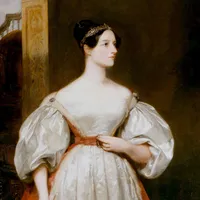 Ada Lovelace (Dec. 10, 1815 – Nov. 27, 1852) was a mathematician and writer from England, who is considered to be the first computer programmer. She was the daughter of the poet Lord Byron and had a great interest in logic and math. She studied with many scientists throughout the course of her life, including Charles Babbage, who is considered to be the father of computers. Her works were inspired by the works of Babbage, and she made a set of notes vital to the development of today’s computers. One of her notes was about the “first computer program,” which included an algorithm that machines could implement. She realized that computers were able to follow simple directions and perform compound calculations, although her discoveries weren’t put into play at that time. It is said that her IQ of 160 was analogous to Albert Einstein and Stephen Hawking.
Ada Lovelace (Dec. 10, 1815 – Nov. 27, 1852) was a mathematician and writer from England, who is considered to be the first computer programmer. She was the daughter of the poet Lord Byron and had a great interest in logic and math. She studied with many scientists throughout the course of her life, including Charles Babbage, who is considered to be the father of computers. Her works were inspired by the works of Babbage, and she made a set of notes vital to the development of today’s computers. One of her notes was about the “first computer program,” which included an algorithm that machines could implement. She realized that computers were able to follow simple directions and perform compound calculations, although her discoveries weren’t put into play at that time. It is said that her IQ of 160 was analogous to Albert Einstein and Stephen Hawking.
Katherine Johnson (Coleman)
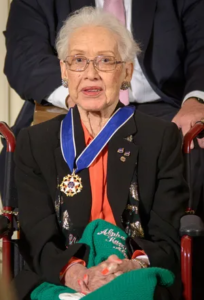 Katherine Johnson (Aug. 26, 1918 – Feb. 24, 2020) was a mathematician who helped with NASA’s development of the journey to the moon. Her interest in and facility with numbers was apparent in her childhood, and she started attending high school at the age of 10. She graduated from West Virginia State University at 18. She then worked in the National Advisory Committee for Aeronautics’ West Area Computing Unit, where she and other women would perform the complex calculations necessary in engineering. Five years later in 1958, this facility changed to become NASA, and 2 years after that, Johnson became the first woman to receive credit for being a coauthor of a NASA research report. Later on in her career, she wrote about 25 more. She played a role in other space missions: her calculation for the path of Freedom 7 allowed the first astronaut in space, and her work helped to launch Apollo 11. She died in 2020 at the age of 101.
Katherine Johnson (Aug. 26, 1918 – Feb. 24, 2020) was a mathematician who helped with NASA’s development of the journey to the moon. Her interest in and facility with numbers was apparent in her childhood, and she started attending high school at the age of 10. She graduated from West Virginia State University at 18. She then worked in the National Advisory Committee for Aeronautics’ West Area Computing Unit, where she and other women would perform the complex calculations necessary in engineering. Five years later in 1958, this facility changed to become NASA, and 2 years after that, Johnson became the first woman to receive credit for being a coauthor of a NASA research report. Later on in her career, she wrote about 25 more. She played a role in other space missions: her calculation for the path of Freedom 7 allowed the first astronaut in space, and her work helped to launch Apollo 11. She died in 2020 at the age of 101.
Althea Gibson
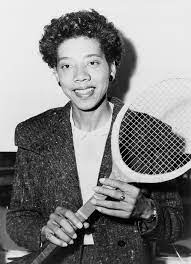 Althea Gibson (Aug. 25, 1927 – Sept. 28, 2003) was a tennis and golf player. She was the first African American tennis player to participate in the U.S. National Championships in 1950 and the first African American to play at Wimbledon in 1951. As a child, she loved playing sports. She didn’t do very well in her academics and skipped school often, but she continued to play and excel in tennis, until the musician Buddy Walker noticed her skills and had her play on local courts. She was introduced to the Harlem River Tennis Courts in 1941, after winning local tournaments and proving she was skilled. She won 10 championships from 1947-1956, and attended Florida A&M University through a sports scholarship. She won both the women’s singles and doubles in Wimbledon in ‘57, and later switched to golf and again became the first Black woman to compete on the pro tour, switching back to tennis soon after. She retired in 1971 and died in 2003.
Althea Gibson (Aug. 25, 1927 – Sept. 28, 2003) was a tennis and golf player. She was the first African American tennis player to participate in the U.S. National Championships in 1950 and the first African American to play at Wimbledon in 1951. As a child, she loved playing sports. She didn’t do very well in her academics and skipped school often, but she continued to play and excel in tennis, until the musician Buddy Walker noticed her skills and had her play on local courts. She was introduced to the Harlem River Tennis Courts in 1941, after winning local tournaments and proving she was skilled. She won 10 championships from 1947-1956, and attended Florida A&M University through a sports scholarship. She won both the women’s singles and doubles in Wimbledon in ‘57, and later switched to golf and again became the first Black woman to compete on the pro tour, switching back to tennis soon after. She retired in 1971 and died in 2003.
Grace Hopper
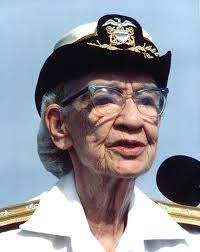 Grace Hopper (Dec. 9,1906 – Jan.1,1992) was a mathematician, computer scientist, and U.S. Navy rear admiral. When she was young, she had a great interest in learning and engineering. At the age of seven, she would take apart items such as clocks and put them back together. She graduated from Vassar College with a bachelor’s degree, and later went to Yale and pursued a Master’s and PhD in mathematics. She resigned from her teaching position in 1943 and joined the Navy. A year later, she was given the role of lieutenant, and her team worked on a prototype of one of the earliest electronic computers. The term “bug,” describing a computer malfunction, was actually coined by Hopper. She wrote a manual on how to work a sequence-controlled calculator, and became a researcher with Harvard. She invented the first computer compiler and co-developed one of the first computer languages. She was then assigned Chief of Naval Operations, after which she was promoted to captain in 1973, commodore in 1983, admiral in 1985, and then was awarded the Defense Distinguished Service Medal. She said her “greatest joy came from teaching,” and she continued with this occupation until her death in 1992.
Grace Hopper (Dec. 9,1906 – Jan.1,1992) was a mathematician, computer scientist, and U.S. Navy rear admiral. When she was young, she had a great interest in learning and engineering. At the age of seven, she would take apart items such as clocks and put them back together. She graduated from Vassar College with a bachelor’s degree, and later went to Yale and pursued a Master’s and PhD in mathematics. She resigned from her teaching position in 1943 and joined the Navy. A year later, she was given the role of lieutenant, and her team worked on a prototype of one of the earliest electronic computers. The term “bug,” describing a computer malfunction, was actually coined by Hopper. She wrote a manual on how to work a sequence-controlled calculator, and became a researcher with Harvard. She invented the first computer compiler and co-developed one of the first computer languages. She was then assigned Chief of Naval Operations, after which she was promoted to captain in 1973, commodore in 1983, admiral in 1985, and then was awarded the Defense Distinguished Service Medal. She said her “greatest joy came from teaching,” and she continued with this occupation until her death in 1992.
Reflection & Final Thoughts
What I find interesting about these women is that their careers and their impact mainly derived from their interest in the topics as kids. For example, Katherine Johnson, Ada Lovelace, and Grace Hopper all had an early affinity for math and calculations, which really impacted the things that they were able to achieve. Even Althea Gibson, who didn’t do too well in school, still pursued an occupation that incorporated her skills and interests, and she continued to look for more things to do as she grew. I believe that these incredible ladies make it clear that you should incorporate the things that you love into your everyday life, and because they are your natural interests, you are more likely to have success, even if it’s just the opportunity to lead a fulfilling and rewarding life.
If you’d like to learn more about the famous women who made an impact on our world, I recommend going to the National Women’s History Museum Website. There, they have many articles and biographies on great women: https://www.womenshistory.org/
Read More
From Twitter to X
Opinion by Azfar Hasin
The social media platform X, formerly known as Twitter, has had a rocky year since billionaire and entrepreneur Elon Musk decided to take it over after a messy purchase finalized in October 2022 for $44 billion. Musk has taken several actions since the acquisition in his efforts to prevent spam bots and remove what he termed as unconstitutional censorship; he has also instituted new subscription options as well as massive layoffs in his efforts to make the platform profitable.
Musk’s stated reason for the purchase was to, in his own words, “reinstate free speech.” He has called himself a free speech absolutist and has unbanned several accounts related to controversial actions or beliefs. One such account that has been unbanned is former President Donald Trump’s, which was suspended in the days following the January 6th attack on the Capitol building in Washington, D.C. He has also reinstated other accounts that were banned for violations of the terms of service relating to hate speech and disinformation. Mr. Musk’s decision to reinstate these accounts have drawn the ire and scrutiny of critics, who have claimed that his actions have supported the far right. In fact, a recent study conducted by the Center for Countering Digital Hate noticed a significant uptick in the rate of hateful comments on the platform since the takeover. This has in turn caused many advertisers to pull their ads from the site, greatly affecting its financial well-being.
The platform previously known as Twitter has also affected Musk’s other companies, such as Tesla, which underwent a steep decline in stock price in the months following the purchase of Twitter. Tesla, an established brand in the electric vehicle industry, faced a sharp decline in its stock due to market concern following the Twitter takeover. The decline was also exacerbated by other considerations, such as the global chip shortage that developed during the early stages of the COVID pandemic. Mr. Musk has reportedly lost 80-90% of Twitter/X’s worth since its purchase, meaning that X is now only worth $4 billion.
To be fair, Twitter has never been a profitable company; instead, its value came from its essential role in the world of news and content generation. In an effort to stop declining profits that have plagued the company since its inception, Elon Musk has pushed Twitter Blue, a subscription service where paid members get access to more features, such as the ability to edit posts and preferential placement, as well as the highly prestigious blue checkmark. Previously, accounts had to go through a formal vetting process to receive such verification. Critics of the platform have derided these changes as opening up the possibilities of impersonation and bot activity while decreasing the prestige of the blue checkmark.
As X’s ad revenue continues to decline, Mr. Musk has threatened to sue the Anti-Defamation League, an organization advocating against antisemitism and hate speech that has been critical of the changes on the platform. Many folks criticized this turn as antisemitic and pointed to the delighted reaction of many confirmed antisemites and neo-Nazis on and off the platform.
Fortunately, those using X and other social media platforms are able to moderate their experiences through a few tools available to them. These tools include making your account private, which limits those who can interact with your posts; blocking or muting unwanted users; and reporting content such as hate speech. In addition, X still includes the Community Notes feature, in which vetted users add clarifying context on posts with disinformation (deliberate falsehoods) and misinformation (incorrect facts). In this way, users can tailor their social media interactions to limit contact with distressing content.
Elon Musk’s leadership over Twitter/X have raised important concerns over the importance of moderation and how far freedom of speech should reach, as well as renewed debate over how social media companies should deal with increasing hate speech. Whether or not Elon Musk’s approach to running a social media platform will be successful, we will have to wait and see.
Read More
Artificial Intelligence
by Anaelle Tadros
Artificial intelligence isn’t a new concept; in fact, in 1956, John McCarthy coined the term at Dartmouth College. However, the topic of AI has become more common and has been popping up in a lot of conversations recently. There have been lots of questions about whether or not AI is beneficial for our society, or if it’s going to ruin and deteriorate the community. It has been especially controversial in terms of its uses in education. Lots of AIs are ones we are familiar with, like Apple’s Siri,  Amazon’s Alexa, and Microsoft’s Cortana. Some other systems use AI too, like Tesla and the latest models from BMW. The car companies use AI algorithms for their self-driving models. Other situations where AI is used are in content creation in marketing, advertising, and movies.
Amazon’s Alexa, and Microsoft’s Cortana. Some other systems use AI too, like Tesla and the latest models from BMW. The car companies use AI algorithms for their self-driving models. Other situations where AI is used are in content creation in marketing, advertising, and movies.
Recently, it’s also been used to help with natural disasters. California’s main firefighting agency is using AI to find visual signs of wildfires. They’re using over a thousand high definition cameras to locate where fires are happening and determine how fast they are spreading. When signs are apparent, the AI models send alerts to the state’s fire department control center to prevent the fires from spreading. The only issue is that human confirmation is required to make sure that these alerts are true and not just false alarms. According to ArsTechnica.com, this has been a problem, with the alerts being frequently set off by fog or by steam from geothermal plants. Setting up these systems also takes a lot of time and effort, and could therefore take away resources and focus from other important emergency initiatives.
AI has a bit of a negative connotation, with many people worried it may soon be able to take over the world. However, our school has used it for a lot of great projects, such as informational posters in the hallways, and many are hoping to incorporate it into our learning environment even more. Because AI is guaranteed to be a part of our generation’s future, our school held a meeting on November 13th to discuss ways our school district could better incorporate AI in the classroom. During this meeting, several people discussed how they use various AI software, while others explained how they use AI in appropriate ways for their own artwork and in drafting college essays. One person used AI for help in compiling their resume and another proposed the idea of using AI to make team shirt designs.
 In this meeting, problems from AI were also discussed, with some mentioning that the suitability of AI’s usage really depends on the person using it. AI can be thought of as a harmful resource because lots of individuals use it to cheat and plagiarize. However, if given to the right person, they will use it as a way to improve their work and learn more deeply. For example, one person may use AI to write an essay, giving them either no benefit in learning how to write effectively themselves or giving them an unfair advantage in the system, while another person may use AI responisibly to give their essay more polish, maybe using it to find stronger phrasing or correct grammar mistakes. A student mentioned using AI to ask questions about a topic they were unclear on from their science class, thus showing how AI allowed them to deepen their understanding. Speaking of cheating, AI is also useful in finding instances of plagiarism. Applications like Turn It In and Grammarly have AI softwares that are used to make sure students aren’t just copying and pasting another person’s work.
In this meeting, problems from AI were also discussed, with some mentioning that the suitability of AI’s usage really depends on the person using it. AI can be thought of as a harmful resource because lots of individuals use it to cheat and plagiarize. However, if given to the right person, they will use it as a way to improve their work and learn more deeply. For example, one person may use AI to write an essay, giving them either no benefit in learning how to write effectively themselves or giving them an unfair advantage in the system, while another person may use AI responisibly to give their essay more polish, maybe using it to find stronger phrasing or correct grammar mistakes. A student mentioned using AI to ask questions about a topic they were unclear on from their science class, thus showing how AI allowed them to deepen their understanding. Speaking of cheating, AI is also useful in finding instances of plagiarism. Applications like Turn It In and Grammarly have AI softwares that are used to make sure students aren’t just copying and pasting another person’s work.
Recently, Principal Mr. Lauchu, Asst. Principal Mr. Rosenthal, Computer Science teacher Mr. Bradfield, and SciFi parent and STEM adviser Mr. Tsao sat down together to discuss the implications of artificial intelligence in the classroom, and LAUSD has released their discussion as a podcast.
Listen here: https://www.lausd.org/Page/16535

To prove the point that AI is quickly being incorporated into so many settings, I used ChatGPT for the first time in my life to write this concluding paragraph:
In conclusion, the advent of artificial intelligence has ushered in a transformative era, reshaping the landscape of industries, society, and human interaction. As AI continues to evolve, its potential for innovation and efficiency is undeniable, offering solutions to complex problems and unlocking new possibilities. However, the ethical implications and potential risks associated with AI demand careful consideration and responsible development. Striking a balance between harnessing the benefits of AI and safeguarding against its potential pitfalls is crucial for a sustainable and inclusive future.
If you have ideas about how AI can help improve our learning, don’t be afraid to share them with our teachers and administators!
Sources:
- What is Artificial Intelligence in 2024? Types, Trends, and Future of it?
- What is Artificial Intelligence (AI) ? | IBM
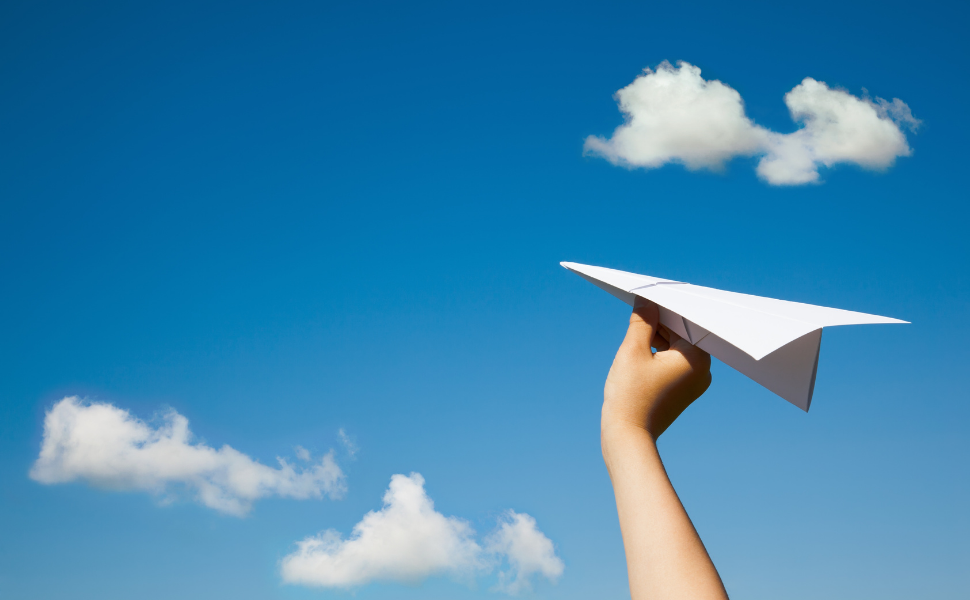
National Paper Airplane Day
by Jordin Lim
National Paper Airplane Day, celebrated each year on May 26th in the United States, is the unofficial observance of a simple, beloved aeronautical toy. This day is commonly celebrated through contests in two basic flight categories: distance and air-time.
Most people are familiar with paper airplanes and enjoy making them frequently. I know that personally, I tend to indulge in making paper airplanes whenever I get bored, but of course never in class (wink).
QUICK TIMELINE OF PAPER AIRPLANE DAY

SCIENCE ACADEMY PAPER AIRPLANE COMPETITION
Here at The Science Academy, Mr. Bradfield’s MakerSpace classes have the wonderful opportunity to participate in Paper Airplane Day at school. Every year, the class goes out to the quad where an intense paper airplane contest is carried out.
There were many creative attempts at winning this competition, with someone actually wrapping up a basketball and claiming it to be their paper airplane. I even caught glimpses of a torpedo-like airplane shooting through the skies.
Overall, the best paper airplane was created by Sutthidol Chainamnaris (8th grade) with a plane that achieved a distance of 94.5 feet!
Will you make the award-winning plane next year? Will your airplane come out on top? Better start practicing now!



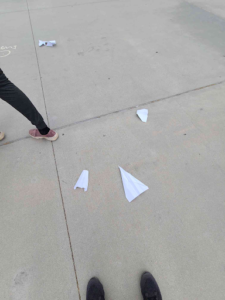
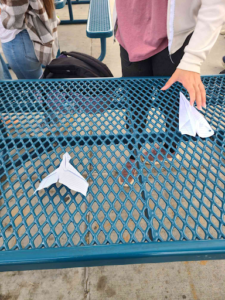
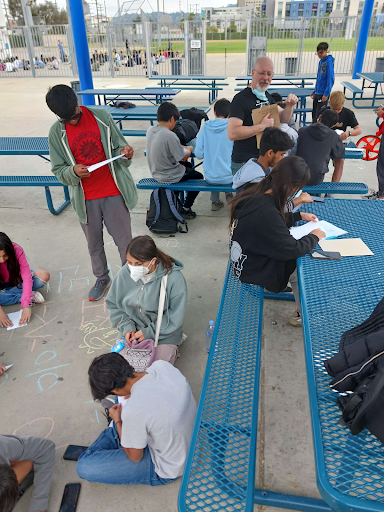
FURTHER INFORMATION ON PAPER AIRPLANES
Do you want to know the science behind paper airplanes? Watch the video below.
Do you want to make some fun paper airplanes? Check out the videos below.
This channel also has really great videos on paper airplanes:
https://youtube.com/@funpaperairplanes)
Read More
Asian American and Pacific Islander Heritage Month
by Ryan Park
During the month of May, the United States recognizes Asian American and Pacific Islander Heritage Month. This celebration, spanning from May 1st to May 31st, honors the contributions and accomplishments of Asian Americans, Pacific Islander Americans, and Native Hawaiians.
Why the month of May?
In 1990, President George H.W. Bush signed a bill that was passed by Congress to expand Asian American Heritage Week into the entirety of the month. Two years later, it was renamed Asian American and Pacific Islander Heritage Month to recognize the contributions of all Americans of Asian descent. The month of May was chosen because it commemorates the first immigration of Japanese Americans on May 7, 1843. In addition, it commemorates the completion of the transcontinental railroad on May 10, 1869, as Asian immigrants made crucial contributions to our country’s first coast-to-coast railway.
Making their Mark in America
An important aspect of the commemoration of AAPI Heritage Month is sharing the many life stories of those of Asian descent.
Born May 31, 1912, Dr. Chien-Shiung Wu is a pivotal figure in the history of physics. An immigrant to the United States from China, she did important work for the nuclear Manhattan Project, helping to develop the process for separating uranium into uranium-235 and uranium-238 isotopes by gaseous diffusion. Wu studied nuclear physics at the University of California, Berkeley where she got the chance to learn from physicists like J. Robert Oppenheimer. She later went on to become the first female instructor in the Physics Department at Princeton University, and her contributions to experimental physics include the Wu experiment, which proved that parity is not conserved.

On March 12, 2023, at the 95th Academy Awards, Malaysian actress Michelle Yeoh made history by becoming the first Asian woman to win an Oscar for Best Actress for the film Everything Everywhere All at Once. You can also find her in other popular movies like Shang Chi; Crazy Rich Asians; Crouching Tiger, Hidden Dragon; and Wicked.

On that same day, Vietnamese-American actor Ke Huy Quan won the Academy Award for Best Supporting Actor for the same movie. Ke Huy Quan was the first Asian to win this award in 38 years! A fun fact is that Ke Huy Quan was the actor who played the part of Short Round, a young boy in the popular Indiana Jones movie series.

Chloe Kim, a Korean-American Olympic snowboarder, is the youngest woman to win an Olympic gold medal in snowboarding. In the 2018 Winter Olympics in Pyeong Chang, Chloe became a gold medalist in the women’s snowboard halfpipe at the age of 17 and later became a two-time Olympic gold medalist. Although she has taken a break from the sport, she is set to return to the 2026 Winter Olympics in Italy.

You can find out more on: https://www.asianpacificheritage.gov/
Read More
The Significance of the Month of Ramadan
by Tarisha Hasan
The holy month of Ramadan takes place on the 9th month of the Islamic lunar calendar. It is during this month that all Muslims observe a fast from before the Fajr, or early morning prayer, until after sunset and the Maghrib evening prayer. During a fast, it is forbidden to eat and drink, with increased emphasis placed on spiritual activities and self-restraint. At the end of this month, Eid-al-Fitr is observed as a celebration and festival for enduring the month-long fast, which can be 29-30 days, depending on when the crescent moon is sighted. This year, Ramadan took place from the evening of March 22nd to the evening of April 20th. If you want to wish someone well during this time, you can say Ramadan Mubarak, which means “Blessed Ramadan”, or Ramadan Kareem, which translates as “Generous Ramadan.“
Why is the month of Ramadan important?
The month is important because fasting during the month is one of the five pillars of Islam. Because of the abstinence from worldly things and desires until the sunset of each day, it also enables communities to unite and comfort one another as we focus on our faith. There is also a strong basis for fasting in the Islamic holy book of the Qur’an and the accompanying Hadith:

- O you who believe! Fasting is prescribed for you as it has been prescribed for those who have believed before you (Surat Al-Baqarah, 2:183)
- It was the month of Ramadan in which the Qur’an was first sent down as guidance for all people, having in it clear proofs of divine guidance and the criterion for right and wrong. So whoever among you bears witness to the month shall then fast it (Surat Al-Baqarah, 2:185)
These quotes from the Qur’an make fasting during this holy month obligatory. The Hadith is the collected traditions of the Prophet Muhammad, based on his sayings and actions. The Hadith support for this is also strong, as shown in the following quote:
- God has said: “All the works of the Son of Adam are for himself but fasting. It is for Me alone, and I shall grant reward for it.” The fast is a safeguard from the Fire. So if ever it is a fasting day for any of you, there shall be neither sexual intimacy nor angered yelling. So if another should trouble or fight someone fasting, let the faster say: “Indeed, I am someone who is fasting.” For by the One in whose Hand is Muhammad’s soul, most surely the faster’s reeking mouth is better to God than the scent of musk. For the faster, there are two joys to rejoice in: When one breaks the fast, one rejoices. And when one meets one’s Lord, one shall rejoice in one’s fasting (Bukhari, no. 1904).
Bukhari is considered to be one of the five individuals who writes the authentic Hadith, but the support for the requirement of fasting still remains strong regardless of the Hadith source. It is important to know that despite the importance of the fast, there are classes of people who are exempt:
- The elderly/disabled or those unable to care for themselves
- Those suffering from serious illness that would hamper their ability to perform the fast
- Children before puberty
The name of the month of Ramadan has its origins in the Arabic word ramad, which translates literally to “dryness”. In ancient Arab times, this lunar month would often be the most difficult to endure due to the extremely high temperatures, especially since Arabia is a desert. Although fasting is one of the main priorities of this lunar month, the real spirit of Ramadan lies in truly understanding the Qur’an and the lessons it has to teach us. What’s more, it also gives one the opportunity to relive the sending down of the Qur’an, which contains the revelation of Islam.
What happens at the end of the month of Ramadan?
The fast is completed at the sighting of the new moon. The observance at the end of the month of Ramadan is known as Eid-al-Fitr. During this festival, all Muslims go to a nearby specialized mosque service in their community in order to carry out the Eid prayer. Before the Ramadan prayer, it is required to give a donation known as a Fitrah. This obligatory donation allows those Muslims in poverty to enjoy Eid-ul-Fitr like all other Muslims. Of course, you have to at least enjoy some sweet desserts during this festival, as this day is also known as “Sweet Eid”. 
There are also plenty of social activities to do, such as gifting fellow Muslims presents, purchasing new clothes, and especially giving to those less fortunate. The main theme of Eid is giving thanks after a long month of fasting. It also centers on spending more time with friends and family. There is no set menu, but the foods should be adequately prepared and also be filling. The clothing is also an important part, because Muslim families around the world always dress their best for the occasion, often in traditional outfits.
In addition, there is also visiting the graves of relatives in order to honor and remember them. In the case of Muslim-majority countries, there are shopping sprees at special “Ramadan markets” as well as local malls. It goes even further; schools are closed as well as businesses. Flowers and decorations adorn homes, and there is a general celebration with good food and good company. This festival isn’t just one day: it can last for up to three to four days, depending on the country’s time zone and regulations. And of course, Eid-al-Fitr is celebrated differently in different countries. The similarities are all shared: the holiday is essentially a new start, regardless of who observes it or where they do it.
Personal Experience
Although the Ramadan fast is meant to be rigorous, by no means is it meant to be difficult. I find it relatively comfortable as I take proper measures to ensure adequate hydration during the morning meal before the fast. I also prioritize a relatively heavy early morning meal as the fast lasts until the evening, which would make approximately 16 hours total, give or take a couple hours. The fast isn’t just about restricting food intake for me, however. It’s also about kicking bad habits to try and better myself. Despite this, I do look forward to Eid, when we will celebrate the completion of the fast.
It’s not just about restricting food and drink. It’s also about learning to control my emotions in order to better myself. More importantly, it helps me realize that all the things that I thought were highly important are actually just trivial matters that I should not waste time worrying about. Fasting also teaches me how to be nicer to people, or sometimes just ignoring the people that aren’t worth my time. I find myself free to do other things, as well as not being obligated to go downstairs for lunch or nutrition if I carry out the fast during school hours.
In terms of physical distress, my main concern is during P.E., when thirst and dehydration are common concerns. However, I just concentrate on doing my best regardless. Many advise that athletes should be certain to let their teachers and coaches know when they are fasting so they can take it into account with regards to activities and rest as needed. Overall during Ramadan, I invest nearly all my time and energy into quickly finishing assignments. The evening meal is a typical meal that often has chickpea curry along with salad and some fruit. Overall, Ramadan seems relatively commonplace to me, but nevertheless, I look forward to Eid and the festivities.
Read More
Middle School Fall Art Contest
By Maleeya Mickelson
The winner of the 2022 Science Academy Middle School Fall Art Contest is Sasha Vitryanyuk for her art submission titled The Beginning of a Cozy, Magical, and Pokemon Fall Season. Sasha won a $25 Amazon gift card after receiving the most votes from the student body.
Additional winners in the art contest include second place winner Dasha Vitryanyuk for her artwork The Beginning of Fall Sprung, and third place winner Hasmik Yedoyan for her submission Pumpkin Still Life. The prize for second place was a fall-themed diamond art painting and sketchbook, while third place won a candy goodie bag.
The following students received honorary mention for their submissions: Alex Lee who drew The Hunter and Rebecca Finklestein who drew Hello My Name is Fall. They each won a bag of candy.
The Fall Art Contest took place from October 14th – November 9th. All of the artwork submitted is currently displayed in the form of a collage in the hallway. During the judging process, ASB narrowed down the entries to 8 pieces. The student body was then able to vote on their favorite artworks via a Google form posted on the Science Academy Student Body Outreach Schoology group.

The Beginning of a Cozy, Magical, and Pokemon Fall Season by Sasha Vitryanyuk
First Place – “This artwork represents the fall season with Pokemon, as many join together and celebrate by sharing their jokes, fruits, chats, and dances. This corresponds to the theme, ‘How do you celebrate fall?’, because I think of the season of fall by hanging out with others, eating together, sharing cultures and facts about each other, and much more! I showed this by adding Pokemon to the artwork, as each of them are chatting, dancing, and eating all together and just having a good time. The setting has many orange, red, brown, and yellow leaves because these are the fall season’s main colors.”

The Beginning of Fall Sprung by Dasha Vitryanyuk
Second Place – “The artwork I made reminded me of how fall changed the weather, the temperature, the colors, and many more fascinating things. This artwork represents how fall changes our atmosphere, when all of the leaves are dried and colored differently. My artwork corresponds to the theme ‘How do we celebrate fall?’ because this piece shows the freedom and peace of walking through a trail of orange, yellow, and red colored trees. Our feelings and attitude of fall describe this piece of art. A person going on a nature walk to see the autumn colored trees is a representation of a festive fall.”

Pumpkin Still Life by Hasmik Yedoyan
Third Place – “My artwork is a picture of a pumpkin made to look imperfect. It corresponds to the theme because pumpkins represent fall, mainly Thanksgiving and Halloween.”

The Hunter by Alex Lee
Honorary Mention – “I drew a man with a boar’s head for a mask. He is a trophy hunter, and autumn is traditionally the hunting season.”

Hello My Name is Fall by Rebecca Finklestein
Honorary Mention – “It represents the multiple aspects of fall and how I celebrate them. Part of it shows candy, which tells that I celebrate Halloween by enjoying candy. The apples dipped in honey are supposed to show celebrating Rosh Ha’Shannah. The books and globes show how I celebrate the start of school by, obviously, going to school and trying my best to get good grades. And finally, the feathers with “Thanksgiving” written on them show celebrating that holiday. The autumn leaves shows nature celebrating by changing the color of its leaves.”
Read More
Evolution of Thanksgiving
by Maleeya Mickelson
Modern day Thanksgiving has evolved significantly since the First Thanksgiving in 1621. From the history of the first feast to Thanksgiving football games and the restaurants families now celebrate in, Americans have put their own stamp on this beloved holiday.
The Story of Thanksgiving
What Americans have come to know as the “First Thanksgiving” is often an oversimplification of events that occurred in 1621 which led up to that feast. Colonists were able to enjoy their bountiful meal because of the Native Americans’ friendship, willingness to help, and experience with survival skills in what is now Massachusetts.
But these Native Americans were not the stereotypical “Indians” some may think of from portraits and cartoon images seen over the years. The Native Americans who took part in the first Thanksgiving were part of the Wampanoag tribe, which still exists today. The Wampanoag had inhabited the land and given thanks for their abundances long before the Europeans arrived. In fact, they did not wear feather headdresses like many images portray and should be acknowledged as an individual tribe with their own diverse cultures and traditions, rather than being lumped together with all tribes under the term “Indians”.

Stereotypical depiction of the “First Thanksgiving”
Before the first Thanksgiving, the Wampanoag negotiated a peace treaty with the colonists to come to each other’s aid. The Wampanoag needed the colonists with their weapons to help defend them against another enemy tribe. In return, the colonists required assistance in learning how to survive by planting native crops, learning to hunt and fish, as well as other ways to successfully live on their new land.
For centuries, the story of this day has only been told through a European’ perspective. Now, with the work of Native Peoples, historians, and educators, more people are learning further details about the story of the “First Thanksgiving”. This changes the way that Native Americans are perceived within history and today’s society by considering the Native Peoples’ rich traditions and cultural diversity.
Thanksgiving Thursdays
Although Americans now know Thanksgiving to be on the 4th Thursday of November, the United States had to come a long way to settle on that date.
Surprisingly, the date of the first Thanksgiving was actually some time in mid-October 1621. It wasn’t until 1668 that the date of November 25th was decided on; however, that date only lasted for 5 years. In 1789, George Washington proclaimed Thursday, November 26th as a day of “sincere and humble thanks”.
Later, when President Abraham Lincoln declared Thanksgiving a national holiday, the date was set to the last Thursday of November. The date stayed the same until 1941 when President Franklin Delano Roosevelt changed Thanksgiving to the 4th Thursday of November in order to give citizens more days for Christmas shopping to increase retail sales to help the economy right after the Great Depression.
While the majority of US holidays fall on a Monday or a specific calendar date, Thanksgiving falls on a Thursday. Although historians aren’t sure as to why Thanksgiving has been on a Thursday since George Washington first announced the holiday, they believe it had to do with religion. When deciding on the date for the holiday, Thursdays were further from the Sabbath day (Sunday) and since religious talks were usually held on Thursday afternoons, it may have worked better with scheduling.
Transforming Traditions
As the holiday of Thanksgiving has spread nationwide, many new traditions have begun to sprout. Some of these include traveling, parades, and Thanksgiving football games.
Many Americans travel for Thanksgiving, whether it’s to visit family or to go on vacation. In fact, every Thanksgiving, about 4 million Americans are estimated to travel 50 or more miles for Thanksgiving. Research also shows that the Wednesday before Thanksgiving has 37% of travelers departing, making it the single busiest day for travel in the year.
Parades like the Macy’s Thanksgiving Day Parade in New York City celebrate Thanksgiving every year. This annual parade started in 1924, originally to promote Christmas shopping at this large department store. The parade includes giant balloons of popular characters, various floats, marching bands and famous performers.

Macy’s Thanksgiving Day Parade
Ever since the first football game on Thanksgiving day occurred in 1876, Thanksgiving has been known for football. The game was the Intercollegiate Football Association championship with the football teams from Yale and Princeton playing. This Thanksgiving game and all the rest to follow were so successful that in 1893, the New York Herald declared Thanksgiving the official football holiday.
After the NFL was founded in 1920, games have been played on Thanksgiving almost every year. Teams like the Detroit Lions and the Dallas Cowboys played a big part in this as the Lions have hosted a game every year on Thanksgiving since 1934 (excluding WWII), while the Cowboys have hosted games most years since 1966.
Similar to football games today, the Pilgrims took part in vaulting, fencing and archery during their Thanksgiving festivities.
Time for the Feast
Although we now think of foods like pumpkin pie and turkey as a staple of Thanksgiving feasts, during the first Thanksgiving, neither of those were present. Foods eaten during the first Thanksgiving were native foods like geese, deer, and squash, which were later replaced with the classic foods many eat for Thanksgiving today like turkey, cranberry sauce, and pumpkin pie.

Typical modern Thanksgiving dinner
Much of the evolution of Thanksgiving foods has occurred because of the diverse cultures here in the U.S. Instead of eating the stereotypical Thanksgiving dinner, some people eat different meals belonging to their culture, such as tamales, lasagna, and vegan dishes.
Along with the different types of food served, the way food was prepared has also evolved. For example, it has long been common for people to oven roast turkey though deep frying it is now gaining in popularity.
Until the last few decades, people may not even have considered having someone else cook their special Thanksgiving dinner, but today it’s quite common. Instead of serving home-cooked meals, people today may go out to a restaurant with family and friends or get food catered – maybe even order Door Dash. It’s also been common to hold Thanksgiving potlucks recently. With potlucks, each individual cooks less food, decreasing holiday stress; plus, having a potluck is a way for people to eat a more diverse meal. They might taste food brought by others that they wouldn’t have had normally for Thanksgiving.
Although celebrated in different ways, the overall idea of Thanksgiving has always been to come together with others and show gratitude. Over time, different parts of the Thanksgiving celebration have changed as people from new cultures have shared their food and traditions, commercialization of the holiday has occurred, and society has gained a better understanding of respecting the culture and diversity of Native Americans.
Read More
Filipino-American Heritage Month
By Jordin Lim
Filipino Heritage Month, spanning from October 1 to October 31, celebrates the heritage and achievements of Filipino Americans. As the second-largest Asian American population in the United States, Filipino Americans have played a significant role in the history, culture, and progression of the United States.
History of Filipino-Americans
October represents Filipino Heritage Month since it marks the important moment when Filipinos first arrived in the continental United States. From 1565 to 1585, Spain ruled the Philippines as a colony. During this time, seafarers would recruit Filipinos on voyages across the Pacific during the Manila galleon trade era. On October 18, 1587, the first-recorded Filipinos arrived aboard a Spanish ship in what is now Morro Bay, California, marking the start of Filipinos’ history in America.
Filipino Contributions to the United States
Filipinos have been a part of American history for many centuries, during which they have made significant contributions to our nation.
- In the early 1920’s, many Filipinos, called manongs, left the Philippines to work in the plantations of Hawaii and California and the fisheries of Washington and Alaska, contributing greatly to the farmworker movement of the U.S.
- During WWII, Filipinos, both in the United States and in the Philippines, fought with and for the United States.
- In the late 60’s and 70’s, many Filipino professionals left their native country to help fill the workforce of the healthcare industry.
- Filipino-Americans have made valuable contributions in the health field, service industry, hospitality, technology, education, government, armed forces and construction, among many other fields.
Filipino Traditions
- Filipino courting
- Harana, Filipino courting, was the traditional form of courtship in the Philippines, in which men wooed a woman of interest by singing underneath her window at night. Suitors would sing their sweetheart romantic songs, usually with a guitar, since its intimate sound complemented the sweet Spanish-influenced songs along with the poetry and lyricism of the Tagalog language.

- Boodle fight
- In Filipino culture, a boodle fight is a traditional way of eating Filipino food with one’s family. A boodle fight is also called a Filipino Kamayan Feast, kamayan translating to “by hand,” describing the method of eating with your hands, which is what you do during a boodle fight, as you a share a meal with family and friends over a banana-leaf filled table filled to the max with many delicious Filipino dishes, such as garlic rice, fried tilapia, mangoes, and salted eggs.

- 4 month Christmas and Parol
- In the Philippines, Christmas isn’t celebrated only in December. As soon as the –ber months begin, Christmas is in season, from September to December. In Filipino houses across the country, parols are usually hung up on the doors of their houses. The parol is a traditional, star-shaped Christmas lantern that represents the star that the three wise men followed.

Notable Filipino-Americans
- Olivia Rodrigo
- Olivia Rodrigo, well-known American singer-songwriter and actress, is Filipino-American through her father’s side of the family. Rodrigo has admired her great-grandfather’s immigration to the United States from the Philippines as a teen.
- Bruno Mars
- Bruno Mars, popular American singer, songwriter, and record producer, was born to a Filipino mother and half Puerto Rican, half Ashkenazi Jewish father.
- Jo Koy
- Jo Koy is a Filipino-American comedian, who recently starred in his film Easter Sunday, which shows his life returning home to celebrate Easter with his Filipino family.
Fun Facts about the Philippines
- When in war, the Philippines flips their flag.
- The Philippines is home to Asia’s first basketball league.
- The Philippines is the largest exporter of nurses globally.
- There are 175+ languages in the Philippines, and at least 171 of them are still considered ‘living’ languages.
- The Philippines is home to three of the world’s largest shopping malls: SM Megamall, SM North Edsa, and SM Mall of Asia.
- The Philippines is an island with more volcanoes than towns.
All in all, Filipino-American History Month is truly important. It celebrates the Filipino/Filipino-American community that has contributed so much to this nation, celebrates the diversity of America, and commemorates the achievements of Filipino-Americans. Today, many people in our community celebrate this month to raise awareness of the role Filipino-Americans have had in U.S. history.
Read More
